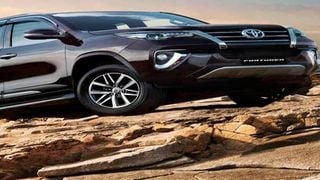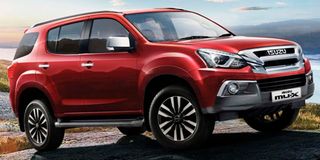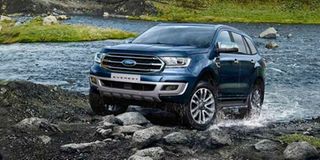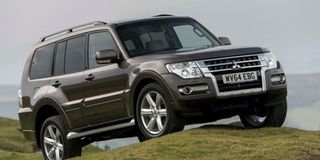
Toyota Fortuner.
| PoolDN2
Premium
JM Baraza: Rate Toyota Fortuner against Ford Everest, Isuzu MUX and Pajero Montero
Baraza,
I am your average motor enthusiast. I know enough to float but not enough to be considered a fanatic, expert or any other adjective that would describe one that is well versed in this area. Same applies to reading your column, I read it when I can and if I deem the topic interesting. I know this not the best pitch to make for your editors to pick my email from the pile.
Anyway, I have a question for you. I read your article on September 1 on the VW Touareg and Toyota Fortuner and wondered how you would rate the Fortuner against locally available 4x4’s not of the German origin, in the case the Ford Everest, Isuzu MUX and the Pajero Montero with Off road capabilities being a key criterion.
Regards,
Mugambi

Hi Mugambi,
Well, you really know how to put your foot in it, don’t you? Being a fanatic is not synonymous with being well versed on a topic, it is just indicative of a deep and frequently irrational love or support for an entity, idea or a cause. I am not sure I’m excited about you reading my column selectively, but hey... at least you do read it, no? I’ll take my wins as they come. My editors were sympathetic enough to pick your email from the pile, so I will answer it.
That class of vehicle of which the Fortuner, Everest, MUX and Montero are members is a fairly unique one in that they are all mid-size, seven-seat SUVs ranking slightly lower than other mid-size, seven-seat SUVs from the same brands, the only difference being this lot has been derived from their respective brands’ double-cab pickups. Their marketing departments will try and deny this, but there’s no fooling an old warhorse like myself: the Fortuner was born of the Hilux, the Everest came from the Ranger, the MUX is a fully clothed DMAX and the Montero is the L200 wagon.
We all know this and no amount of marketing parlance is going to convince us otherwise. Their off-road capabilities should be broadly similar since all these vehicles boast the same underpinnings: selectable 4WD with low range and locking diffs. They all have very short front and rear overhangs which makes for good approach (AA) and departure angles (DA).
They’re all three-row SUVs on jacked up suspensions so breakover angles (BA) may be determined by which one is kitted with a sidestep and which one isn’t. This in turn determines the running clearance (GC). However, this is where we have to deal with numbers to separate the Isuzus from the Mitsubishis, so we start our list with the yardstick: the Toyota Fortuner.

Ford Everest.
1. Toyota Fortuner: 30 degrees AA, 25 degrees DA, 23.5 degrees BA, 279mm of GC
2. Pajero Sport (Montero): 30 degrees AA, 24.2 degrees DA, 23.1 degrees BA, 218mm of GC. The Pajero/Montero is the first one to be eliminated from the running, having been roundly beaten by the Fortuner on all counts except for the approach angle which is a tie at 30 degrees. Next victim...
3. Ford Everest: 29.5 degrees AA, 25 degrees DA, 21 degrees BA, 225mm of GC. Well, this one is not only comprehensively shown up by the Toyota, it actually loses out to the Mitsubishi too! Haha…
4. Isuzu MUX: 29.2 degrees AA, 26.4 degrees DA, 23.1 degrees BA, 235mm of GC. Yet another attempt at matching the Toyota’s stats, yet another failure in that attempt.
Now these numbers are a good indicator of how capable the vehicles will be off-road, but they’re highly theoretical. In the real world, driver and spotter skill will matter a lot more for a successful jaunt off the unbeaten path compared to a 0.8-degree difference in approach angle. The Fortuner still wins here, because incidentally, it won our Motoring Press Agency Car of The Year Award 2018 quite convincingly back then, and here at the agency, we take the guesswork out of these nominations.

Mitshubishi Shogun.
We liked the performance (Montero cannot match), we liked the refinement (MUX cannot match), we liked the Lexus-lite looks, we liked the interior, we liked the economy, and of course Toyotas are legendary as far as dependability goes (Everest cannot match). This year, we have the Isuzu MUX in the running for Car of The Year. Will it inherit the trophy from its rival? We can only wait and see what happens at the ceremony next month, but here is a teaser. The competition is very tough this year. Among the finalists are the Sagak Tech BJ50 (Sh 450,000 only) and a Mazda CX-9 (German sensations and Japanese technology at Korean prices). There are yet others. Stay tuned, it will be an interesting one...
The more the tech, the less reliable a vehicle becomes

Hello JM
Kudos for the fantastic performance in advising us less-knowledgeable motorists on matters motoring delivered in flowery English. I seek your expert views on the following:
1. I have noted that new vehicles are loaded with so much technology. I believe the more the tech, the less reliable the vehicle becomes, besides, some of the tech will be competing with the driver for control of the vehicle. For example, what is the purpose of rain sensitive wipers or lane departure sensors? Surely an alert driver/petrol head shouldn’t need assistance with such tasks.
2. What science informs the tradition of redlining most cars at between 6.5-8,000 engine RPM?
Thanks in advance
Muliba
Hi Muliba,
1. I agree with you: the more the tech, the less reliable the vehicle since more tech means more things to go wrong. Some of the tech competes with the driver for control of the vehicle because studies and observations reveal that a large number of drivers out there abuse, misuse or underuse that control... or don't even use it at all. Carelessness and incompetence contribute to a significant portion of road traffic injuries and fatalities. Since it is impossible to force common sense, it is easier to make their tools of trade as fool proof as possible.
Rain-sensing wipers? These are for convenience... for the most part. But they also work against the kind of egomaniacs who want to prove a point to a non-existent audience (I can drive with no wipers and you can't tell me nothing). Lane departure warnings? They work against straddlers (the kind who don't want to be overtaken) and the chronically sleepy. Start dozing off, your car wanders off its line, it will wake you up with either an annoying beep or a low frequency vibration of the steering wheel.
An alert driver doesn't need this technology, but not everyone is an alert driver, and those in the second category are responsible for the grim road safety statistics we have globally. The tech is there to protect us from them, and them from themselves.
2. Material science is responsible for most cars being redlined at 6,500 - 8,000 rpm (for petrol engines). Revving any higher will cause the materials the engine is made out of to start losing or changing the same characteristics they were sought for in the first place. There are other considerations as well:
1. Application: you don't need a high revving engine (top end power) if it is for commercial or intra-urban use
2. Economy: you don't need a high revving engine (high fuel consumption) outside the world of sports or performance cars.
3. Engine life: high revving engines don't last very long. To offer the customer the best horsepower per coin, engine performance is tuned to within that range to maximise life while maintaining usability.





